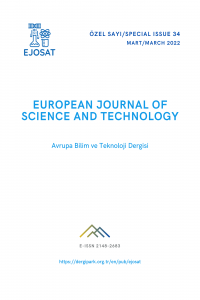Öz
Beginning in the early 1990s, environmental concerns began to take a more prominent position on the world agenda. The necessity for establishing a relationship between architecture and nature has become apparent as a result of increased public awareness of the repercussions of uncontrolled urban expansion and climate change. The consequences of reforms aimed at integrating environmentally friendly solutions into the construction of buildings have altered public perceptions of the modern built environment. Although this relationship is perceived as new, it is rooted in ancient times. Over the course of history, many architects have recognized the need of developing a link with the environment and have taken steps to achieve this relationship. Antoni Gaudi is one of the architects who made a significant contribution to this collaboration. The aim of this article is to rediscover the relationship between nature and architecture through the works of Antoni Gaudi.
Anahtar Kelimeler
Sustainable architecture Energy efficiency Biomimicry Antoni Gaudi.
Kaynakça
- Ruskin, J. (1849). The seven lamps of architecture. New York, NY, USA: J. Wiley.
- Miller, E. (2011). Sustainable Socialism: William Morris on Waste. The Journal of Modern Craft, 4, 7–25. https://doi.org/10.2752/174967811X12949160068974
- Emekci, S. (2021). Nature-centered design: a comparative analysis in current architectural approaches. Presented at the LIVENARCH VII livable environments & architecture, Trabzon, Turkey.
- Kim soyeon & Yoon Jae Eun. (2015). A Study on Organic Architecture Characteristics in Works of Gaudi and Hundertwasser. 한국공간디자인학회 논문집, 10(6), 23–32.
- Mumford, M. (1989). Form Follows Nature: The Origins of American Organic Architecture. Journal of Architectural Education, 42(3), 26–37. https://doi.org/10.1080/10464883.1989.10758528
- Pawlyn, M. (2019). Biomimicry in architecture. Routledge.
- Amer, N. (2019). Biomimetic Approach in Architectural Education: Case study of ‘Biomimicry in Architecture’ Course. Ain Shams Engineering Journal, 10(3), 499–506. https://doi.org/10.1016/j.asej.2018.11.005
- González Moreno-Navarro, A. (1990). Gaudí, constructor (la materialización de una arquitectura singular). González Moreno-Navarro, 42(408), 5–8. https://doi.org/10.3989/ic.1990.v42.i408.1423
- Mirat, C., Bedoya, C., & Adell, J. (2018). Antonio gaudí, the forerunner of sustainability and biomimicry in architecture, 100 years in advance. Architecture, City and Environment, 12, 71–98. https://doi.org/10.5821/ace.13.37.5348
- Pantano, M. (2013). Reading Gaudí’ Reading Gaudí’s Great Book of Nature Reconsidering the Peripher peripheral Reception of al Reception of Proto-Environmental Architecture. The University of Pennsylvania.
- Nonell, J. (2012). La construcción tradicional en la arquitectura de Gaudí. Informes de La Construcción, 42, 9–14. https://doi.org/10.3989/ic.1990.v42.i408.1424
- Guardiola Usón, E., & Cunill de la Puente, E. (2005). Passive solar design in Antonio Gaudi’s domestic architecture (p. 4). Presented at the International Conference “Passive and Low Energy Cooling for the Built Environment,” Santorini, Greece.
- ArchDaily. (2021). Gallery of New Interior for Casa Batlló Stairs & Atrium / Kengo Kuma & Associates - 14. Retrieved January 17, 2022, from https://www.archdaily.com/967908/new-interior-for-casa-batllo-stairs-and-atrium-kengo-kuma-and-associates/613141b825f70e016663f5bc-new-interior-for-casa-batllo-stairs-and-atrium-kengo-kuma-and-associates-section
- Bassegoda, J. (1989). El gran Gaudí. Ausa: Sabadell.
- EMARQ. (2021). Casa Milà (La Pedrera) obra de Antoni Gaudí - EMARQ. Retrieved January 17, 2022, from https://www.emarq.net/blog/casa-mila-la-pedrera
Öz
1990'ların başlarından itibaren çevresel kaygılar dünya gündeminde daha fazla yer almaya başladı. Kontrolsüz kentsel genişleme ve iklim değişikliğinin yansımaları konusunda artan kamuoyu bilincinin bir sonucu olarak, mimarlık ve çevre arasında ilişki kurmanın gerekliliği ortaya çıkmıştır. Çevre dostu çözümleri binaların inşasına entegre etmeyi amaçlayan reformların sonuçları, modern yapılı çevreye ilişkin kamu algısını değiştirmiştir. Bu ilişki yeni gibi algılansa da kökleri çok eskilere dayanmaktadır. Tarih boyunca birçok mimar, çevre ile bir bağ geliştirmenin gerekliliğini fark etmiş ve bu ilişkiyi gerçekleştirmek için adımlar atmıştır. Antoni Gaudi, bu iş birliğine önemli katkı sağlayan mimarlardan biridir. Bu makalenin amacı çevre ve mimarlık ilişkisini Antoni Gaudi'nin eserleri üzerinden yeniden keşfetmektir.
Anahtar Kelimeler
Sürdürülebilir mimari Enerji verimliliği Biyomimikri Antoni Gaudi.
Kaynakça
- Ruskin, J. (1849). The seven lamps of architecture. New York, NY, USA: J. Wiley.
- Miller, E. (2011). Sustainable Socialism: William Morris on Waste. The Journal of Modern Craft, 4, 7–25. https://doi.org/10.2752/174967811X12949160068974
- Emekci, S. (2021). Nature-centered design: a comparative analysis in current architectural approaches. Presented at the LIVENARCH VII livable environments & architecture, Trabzon, Turkey.
- Kim soyeon & Yoon Jae Eun. (2015). A Study on Organic Architecture Characteristics in Works of Gaudi and Hundertwasser. 한국공간디자인학회 논문집, 10(6), 23–32.
- Mumford, M. (1989). Form Follows Nature: The Origins of American Organic Architecture. Journal of Architectural Education, 42(3), 26–37. https://doi.org/10.1080/10464883.1989.10758528
- Pawlyn, M. (2019). Biomimicry in architecture. Routledge.
- Amer, N. (2019). Biomimetic Approach in Architectural Education: Case study of ‘Biomimicry in Architecture’ Course. Ain Shams Engineering Journal, 10(3), 499–506. https://doi.org/10.1016/j.asej.2018.11.005
- González Moreno-Navarro, A. (1990). Gaudí, constructor (la materialización de una arquitectura singular). González Moreno-Navarro, 42(408), 5–8. https://doi.org/10.3989/ic.1990.v42.i408.1423
- Mirat, C., Bedoya, C., & Adell, J. (2018). Antonio gaudí, the forerunner of sustainability and biomimicry in architecture, 100 years in advance. Architecture, City and Environment, 12, 71–98. https://doi.org/10.5821/ace.13.37.5348
- Pantano, M. (2013). Reading Gaudí’ Reading Gaudí’s Great Book of Nature Reconsidering the Peripher peripheral Reception of al Reception of Proto-Environmental Architecture. The University of Pennsylvania.
- Nonell, J. (2012). La construcción tradicional en la arquitectura de Gaudí. Informes de La Construcción, 42, 9–14. https://doi.org/10.3989/ic.1990.v42.i408.1424
- Guardiola Usón, E., & Cunill de la Puente, E. (2005). Passive solar design in Antonio Gaudi’s domestic architecture (p. 4). Presented at the International Conference “Passive and Low Energy Cooling for the Built Environment,” Santorini, Greece.
- ArchDaily. (2021). Gallery of New Interior for Casa Batlló Stairs & Atrium / Kengo Kuma & Associates - 14. Retrieved January 17, 2022, from https://www.archdaily.com/967908/new-interior-for-casa-batllo-stairs-and-atrium-kengo-kuma-and-associates/613141b825f70e016663f5bc-new-interior-for-casa-batllo-stairs-and-atrium-kengo-kuma-and-associates-section
- Bassegoda, J. (1989). El gran Gaudí. Ausa: Sabadell.
- EMARQ. (2021). Casa Milà (La Pedrera) obra de Antoni Gaudí - EMARQ. Retrieved January 17, 2022, from https://www.emarq.net/blog/casa-mila-la-pedrera
Ayrıntılar
| Birincil Dil | İngilizce |
|---|---|
| Konular | Mühendislik |
| Bölüm | Makaleler |
| Yazarlar | |
| Erken Görünüm Tarihi | 30 Ocak 2022 |
| Yayımlanma Tarihi | 31 Mart 2022 |
| Yayımlandığı Sayı | Yıl 2022 Sayı: 34 |


